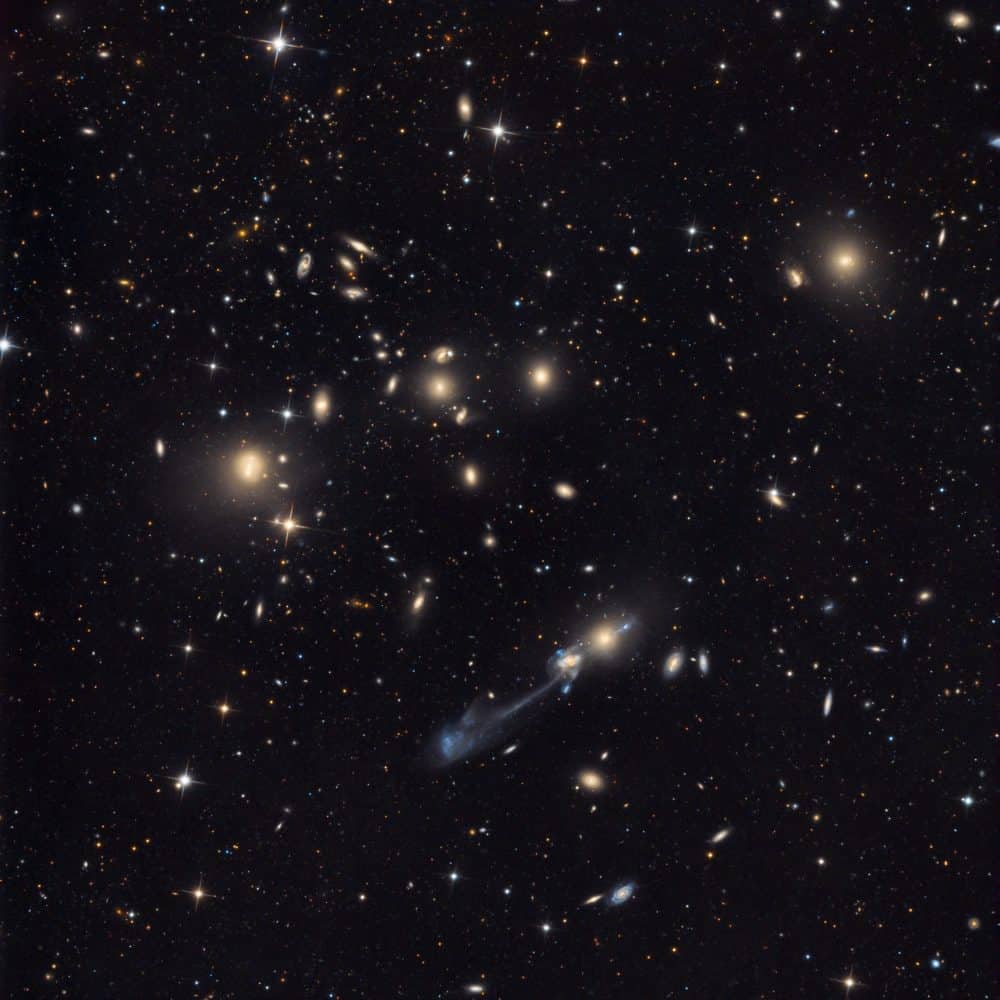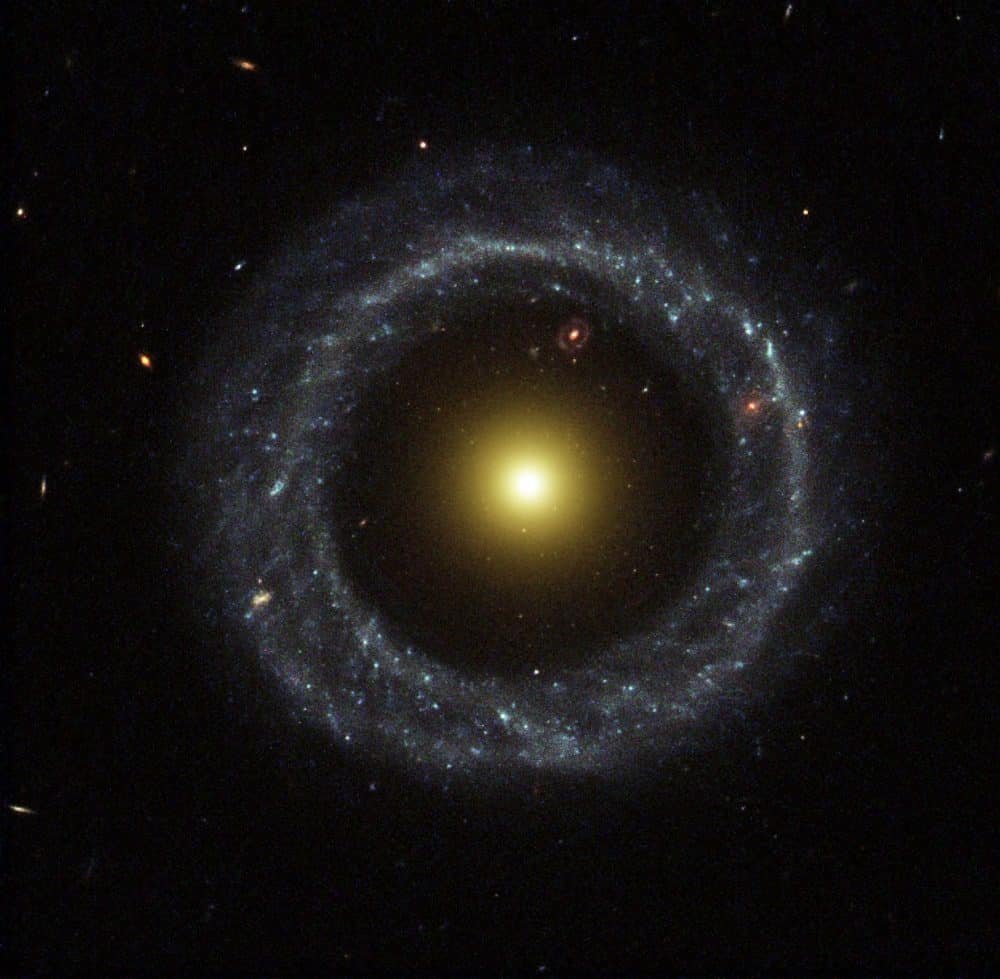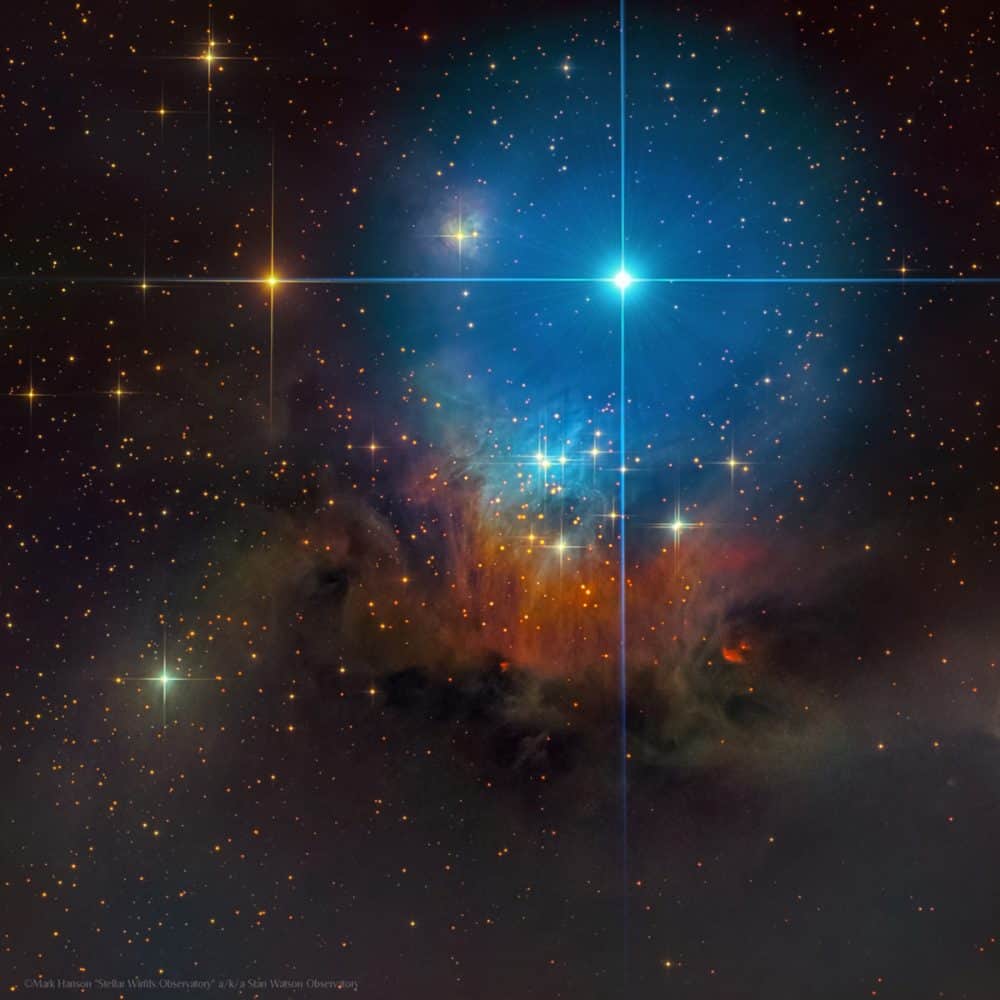Blog
Rim Banna (Arabic: ريم بنا; 8 December 1966 – 24 March 2018) was a Palestinian singer, composer, arranger and activist, who was most known for her modern interpretations of traditional Palestinian songs and poetry. Banna was born in Nazareth, where she graduated from Nazareth Baptist School. She lived in Nazareth with her three children. She met her husband, Ukrainian guitarist Leonid Alexeyenko, while studying music together at the Higher Music Conservatory in Moscow and they married in 2001, and got divorced in 2010.
Banna died in her hometown of Nazareth on 24 March 2018 following a nine-year struggle with breast cancer.
more...Arp 105 is in a spectacular field of galaxies. It’s in the class E and E-like Galaxies Connected to Spirals. The Arp is the long structure running N-S, about halfway from the center of the field to the east edge. The brighter galaxy to the south is NGC 3561 and the companion, about 1′ north, is NGC 3561A. The little elliptical(?) just south of NGC 3561 is known as Ambartsumian’s Knot. As you can see, there are quite a few other knots, galaxies, etc., in this structure. Also in the field, NGC 3550 is the bright object toward the northwest corner, just west of the bright star. There are three more NGC’s, 3553, 52, and 54, all in a line starting not quite 4′ south of 3550 and angling SSE. NGC 3553 is not particularly bright — there are a number of brighter galaxies in the field that did not make the better known catalogs. The entire field is completely inside Abell Galaxy Cluster 1185.
more...Omar Sosa (born April 10, 1965) is a Cuban-born composer, bandleader, and jazz pianist. Born in Camagüey, Cuba, Sosa began studying marimba at the age of eight, then switched to piano at the Escuela Nacional de Musica in Havana, where he studied jazz. Sosa moved to Quito, Ecuador, in 1993, then San Francisco, California, in 1995. In San Francisco he became deeply involved in the local Latin jazz scene and began a long collaboration with percussionist John Santos. He also made a series of recordings with producer Greg Landau, including the ground-breaking Oaktown Irawo, featuring Tower of Power drummer Dave Garibaldi, Cuban saxophonist Yosvany Terry and Cuban percussionist Jesus Diaz. Sosa and Landau recorded with Carlos “Patato” Valdes and Pancho Quinto and worked on several film scores. Around 1999 Sosa moved to Barcelona, Catalonia.
Neville O’Riley Livingston, OM (born 10 April 1947), best known as Bunny Wailer, is a Jamaican singer songwriter and percussionist and was an original member of reggae group The Wailers along with Bob Marley and Peter Tosh. A three-time Grammy award winner, he is considered one of the longtime standard-bearers of reggae music. He is also known as Bunny Livingston and affectionately Jah B.
The young Neville Livingston spent his earliest years in the village of Nine Mile in St. Ann Parish. It was there that he first met Bob Marley, and the two toddlers befriended each other quickly. The boys both came from single-parent families; Livingston was brought up by his father, Marley by his mother. Later, Bunny’s father Thaddeus “Toddy” Livingston lived with Bob Marley‘s mother Cedella Booker and had a daughter with her named Pearl Livingston. Peter Tosh had a son, Andrew Tosh, with another of Bunny’s sisters, Shirley, making Andrew his nephew.
Bunny had originally gone to audition for Leslie Kong at Beverley’s Records in 1962, around the same time Bob Marley was cutting “Judge Not”. Bunny had intended to sing his first composition, “Pass It On”, which at the time was more ska-oriented. However, Bunny was late getting out of school, missed his audition, and was told he wasn’t needed. A few months later, in 1963; he formed “The Wailing Wailers” with his step-brother Bob Marley and friend Peter Tosh, and the short-lived members Junior Braithwaite and Beverley Kelso. As he was by some way the least forceful of the group, he tended to sing lead vocals less often than Marley and Tosh in the early years, but when Bob Marley left Jamaica in 1966 for Delaware, replacing Bunny with Constantine “Vision” Walker, he began to record and sing lead vocals on some of his own compositions, such as “Who Feels It Knows It”, “I Stand Predominant” and “Sunday Morning”. His music was very influenced by gospel and the soul of Curtis Mayfield. In 1967, he recorded “This Train”, based on a gospel standard, for the first time, at Studio One.
He was arrested on charges of possession of cannabis in June 1967 and served a 14-month prison sentence.
As the Wailers regularly changed producers in the late-1960s he continued to be underused as a writer and lead vocalist, though was a key part of the group’s distinctive harmonies. He sang lead on “Dreamland” (a cover of El Tempos’ My Dream Island, which soon became Bunny’s signature song), “Riding High”, “Brainwashing” and on one verse of the Wailers’ Impressions-like “Keep On Moving”, both produced by Lee “Scratch” Perry.
more...Rosco N. Gordon III (April 10, 1928 – July 11, 2002) was an American blues singer and songwriter. He is best known for his hit songs “Booted” and “No More Doggin'” (1952) and “Just a Little Bit” (1960). Gordon was born in Memphis, Tennessee. He was a pioneer of the Memphis blues style and in the late 1940s and early 1950s was associated with Johnny Ace, Bobby Bland and B.B. King, sometimes referred to as the “Beale Streeters”. He made a number of his early recordings for Sam Phillips at Sun Records. Gordon played piano in a style known as “the Rosco rhythm”, with the emphasis on the off-beat. This rhythm was an influence on the Jamaican pianist Theophilus Beckford and hence on reggae music as a whole.
“Booted” and “No More Doggin'” were both released in 1952. Phillips sold the master of “Booted” to both RPM (owned by the Bihari brothers) and Chess Records (owned by Leonard and Phil Chess), and both labels released the track as a single. The RPM release reached number one on the Billboard R&Brecord chart. Chess and the Bihari brothers later settled the conflict, with the Biharis getting exclusive rights to Gordon and Chess signing Howlin’ Wolf to an exclusive contract.
https://www.youtube.com/watch?v=-n3M6SUAqhk
more...Hoag’s Object is a non-typical galaxy of the type known as a ring galaxy. The galaxy is named after Arthur Hoag who discovered it in 1950 and identified it as either a planetary nebula or a peculiar galaxy with eight billion stars.
A nearly perfect ring of young hot blue stars circles the older yellow nucleus of this ring galaxy c. 600 million light-years away in the constellation Serpens. The diameter of the 6 arcsecond inner core of the galaxy is about 17±0.7 kly (5.3±0.2 kpc) while the surrounding ring has an inner 28″ diameter of 75±3 kly (24.8±1.1 kpc) and an outer 45″ diameter of 121±4 kly (39.9±1.7 kpc), which is slightly larger than the Milky Way Galaxy.
Even though Hoag’s Object was clearly shown on the Palomar Star Survey, it was not included in either the Morphological Catalogue of Galaxies, the Catalogue of Galaxies and Clusters of Galaxies, or the catalogue of galactic planetary nebulae.
In the initial announcement of his discovery, Hoag proposed the hypothesis that the visible ring was a product of gravitational lensing. This idea was later discarded because the nucleus and the ring have the same redshift, and because more advanced telescopes revealed the knotty structure of the ring, something that would not be visible if the ring were the product of gravitational lensing.
more...Stephen Kendall Gadd (born April 9, 1945) is an American drummer, percussionist, and session musician. Gadd is one of the most well-known and highly regarded session and studio drummers in the industry, recognized by his induction into the Modern Drummer Hall of Fame in 1984. Gadd’s performance on Paul Simon‘s “50 Ways to Leave Your Lover“, “Late In The Evening” and Steely Dan‘s “Aja” are examples of his style. He has worked with popular musicians from many genres including Simon & Garfunkel, Steely Dan, James Taylor, Eric Clapton, Kate Bush, Joe Cocker, Grover Washington Jr., Chick Corea, Lee Ritenour, Paul Desmond, Chet Baker and Al Di Meola.
Chick Corea once commented, “Every drummer wants to play like Gadd because he plays perfect…. He has brought orchestral and compositional thinking to the drum kit while at the same time having a great imagination and a great ability to swing.
more...Carl Lee Perkins (April 9, 1932 – January 19, 1998) was an American singer-songwriter who recorded most notably at the Sun Studio, in Memphis, beginning in 1954. Amongst his best-known songs are ‘Blue Suede Shoes‘, ‘Matchbox‘ and ‘Everybody’s Trying To Be My Baby‘.
According to Charlie Daniels, “Carl Perkins’ songs personified the rockabilly era, and Carl Perkins’ sound personifies the rockabilly sound more so than anybody involved in it, because he never changed.” Perkins’s songs were recorded by artists (and friends) as influential as Elvis Presley, the Beatles, Jimi Hendrix, Johnny Cash and Eric Clapton which further established his place in the history of popular music. Paul McCartney claimed that “if there were no Carl Perkins, there would be no Beatles.”
Called “the King of Rockabilly”, he was inducted into the Rock and Roll Hall of Fame, the Rockabilly Hall of Fame, the Memphis Music Hall of Fame, and the Nashville Songwriters Hall of Fame. He also received a Grammy Hall of Fame Award.
Perkins was born near Tiptonville, Tennessee, the son of poor sharecroppers, Buck and Louise Perkins (misspelled on his birth certificate as “Perkings”). He grew up hearing southern gospel music sung by white friends in church and by African-American field workers when he worked in the cotton fields.
https://www.youtube.com/watch?v=gRpSuB2Iz5k&list=PLEB3LPVcGcWarNCmxV7UeFbgQ19VyJ1so&index=2&t=0s
more...Mance Lipscomb (April 9, 1895 – January 30, 1976) was an American blues singer, guitarist and songster. He was born Beau De Glen Lipscomb near Navasota, Texas. As a youth he took the name Mance (short for emancipation) from a friend of his oldest brother, Charlie.
He was discovered and recorded by Mack McCormick and Chris Strachwitz in 1960, during a revival of interest in the country blues. He recorded many albums of blues, ragtime, Tin Pan Alley, and folk music (most of them released by Strachwitz’s Arhoolie Records), singing and accompanying himself on acoustic guitar. Lipscomb had a “dead-thumb” finger-picking guitar technique and an expressive voice. He honed his skills by playing in nearby Brenham, Texas, with a blind musician, Sam Rogers.
His first release was the album Texas Songster (1960). Lipscomb performed songs in a wide range of genres, from old songs such as “Sugar Babe” (the first he ever learned), to pop numbers like “Shine On, Harvest Moon” and “It’s a Long Way to Tipperary“.
more...IC 348 is a star-forming region in the constellation Perseus located about 315 parsecs from the Sun. It consists of nebulosity and an associated 2-million-year-old cluster of roughly 400 stars within an angular diameter of 20″. The most massive stars in the cluster are the binary star system BD+31°643, which has a combined spectral class of B5. Based upon infrared observations using the Spitzer Space Telescope, about half of the stars in the cluster have a circumstellar disk, of which 60% are thick or primordial disks. The age of this cluster has allowed three low mass brown dwarfs to be discovered. These objects lose heat as they age, so they are more readily discovered while they are still young
IC 348 (also known as IC 1985) is a rarely imaged open star cluster surrounded by a reflection nebula. The reason this object is not imaged is due to the very bright star glare washing most of the detail away. Countless hours slowly expanding this image to fight of the glare and reveal the wonderful image you see here. The light from the roughly 400 stars in the cluster is scattered by clouds of dust in the star-forming region, producing the reflection nebula.
more...John Charles Julian Lennon (born 8 April 1963) is an English musician and photographer, son of The Beatles member John Lennon and his first wife Cynthia.
He was the direct inspiration for three Beatles’ songs: “Lucy in the Sky with Diamonds” (1967), “Hey Jude” (1968), and “Good Night” (1968). His parents divorced in 1968, and he is half-brother to Sean Lennon. He has produced a number of albums starting with Valotte (1984), as well as a documentary film WhaleDreamers on an environmental theme. Lennon has also held exhibitions of his photography.
Lennon inspired one of his father’s most famous songs, “Lucy in the Sky with Diamonds,” whose lyrics describe a picture the boy had drawn, a watercolor painting of his friend, Lucy O’Donnell, from nursery school, surrounded by stars. Another composition of his father inspired by him was the lullaby “Good Night“, the closing song of The Beatles (also known as The White Album). In 1967, he attended the set of the Beatles’ film Magical Mystery Tour.
more...Paul Jeffrey (April 8, 1933 – March 20, 2015) was an American jazz tenor saxophonist, arranger, and educator. He was a member of Thelonious Monk‘s regular group from 1970–1975, and also worked extensively with other musicians such as Charles Mingus, Dizzy Gillespie, Clark Terry, Lionel Hampton and B.B. King.
Born in New York City, Jeffrey attended Kingston High School. After graduating in 1951, he completed a Bachelor of Science degree in music education at Ithaca College in 1955. He spent the late 1950s touring with bands led by Illinois Jacquet, Elmo Hope, Big Maybelle, and Wynonie Harris. From 1960 to 1961, Jeffrey toured the US with B.B. King, after which he worked as a freelance musician in the New York City area and toured with bands led by Howard McGhee, Clark Terry, and Dizzy Gillespie.[5]
Jeffrey’s first studio work as a leader was in 1968, when he recorded the album Electrifying Sounds for Savoy Records. He toured with the Count Basie Orchestra before beginning his associations with Thelonious Monk and Charles Mingus. He first joined Monk’s quartet for a multi-day run at the Frog & Nightgown club in Raleigh, North Carolina, in May 1970.
https://www.youtube.com/watch?v=SbbG23uOnlY
more...Carmen Mercedes McRae (April 8, 1922 – November 10, 1994) was an American jazz singer. She is considered one of the most influential jazz vocalists of the 20th century and is remembered for her behind-the-beat phrasing and ironic interpretation of lyrics. McRae was inspired by Billie Holiday, but she established her own voice. She recorded over sixty albums and performed worldwide. McRae was born in Harlem. Her father, Osmond, and mother, Evadne McRae, were immigrants from Jamaica.
In her late teens and early twenties, McRae played piano at a New York City club called Minton’s Playhouse, Harlem’s most famous jazz club, sang as a chorus girl, and worked as a secretary. It was at Minton’s where she met trumpeterDizzy Gillespie, bassist Oscar Pettiford, and drummer Kenny Clarke, had her first important job as a pianist with Benny Carter’s big band (1944), worked with Count Basie (1944) and under the name “Carmen Clarke” (having married Kenny Clarke)[3] made her first recording as pianist with the Mercer Ellington Band (1946–47). But it was while working in Brooklyn that she came to the attention of Decca’s Milt Gabler. Her five-year association with Decca yielded 12 LPs.
more...More Posts
- Billy Childs
- Gábor Szabó
- George Coleman
- Mississippi John Hurt
- World Music with Kateryna Pavlenko & Go_A
- Daily Roots with Bob Marley
- Cosmos HH34
- Townes Van Zandt
- Louis Cottrell Jr
- Alcide Louis “Slow Drag” Pavageau
- Maurice Ravel
- SUPPORT UKRAINE World Music from Ukraine with Doox
- Daily Roots with Don Carlos
- The Dragon Who Like Spit Fire-FINAL PERFORMANCE
- Cosmos Venus Eclipse
- David Gilmour
- Flora Purim
- Wes Montgomery
- Howard McGhee
- Bob Wills


